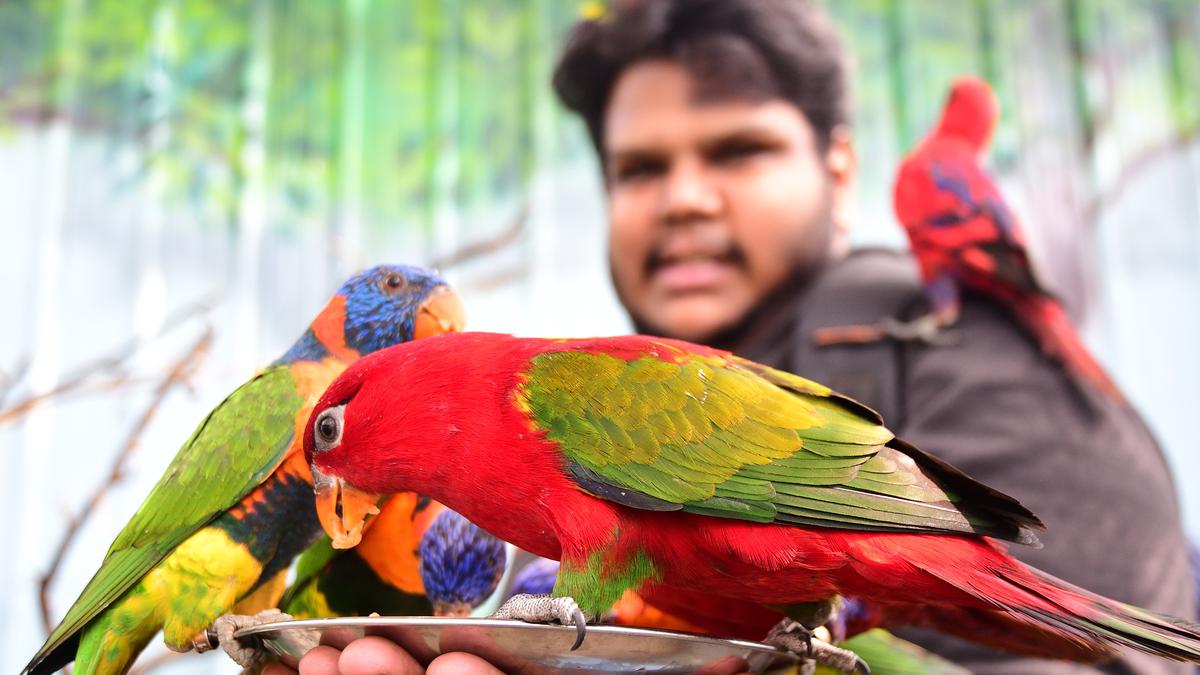
The grey in the colourful plumage
The Hindu
The grey in the colourful plumage
In an exotic bird park at Mettupalayam in Coimbatore district, Kookyland, visitors are charged ₹200 in entry fee. These exotic birds include macaws, the endangered African grey parrot, conures and lorikeets. The other exhibits include diamond doves, hedgehogs, exotic pythons, dwarf hamsters and iguanas. “All the species in my collection are foreign species that are allowed to be kept in India,” says M.M. Sridhar, of Kookyland. “We have declared all the species in our collection in the Parivesh portal as per norms and officials of different departments also inspect the park often,” he adds.
Similar private aviaries have started springing up across Tamil Nadu over the last few years with a boom in the interest among people in interacting with exotic wildlife. Has this interest brought on a rapacious industry thriving on the trade in exotic animals, many of which are often illegally trafficked into the country? While the trade in native Indian species of wildlife is protected by the Wild Life (Protection) Act, 1972, animals brought into India from other countries till recently had very little oversight once they entered Indian borders. From aviaries to private zoos, the lack of regulation of the sale and exhibition of non-native fauna could drive the threatened species towards extinction in other countries, besides endangering the local biodiversity, experts caution.
In the 2023 newsletter, ‘TRAFFIC Post’, on wildlife trade in India, Astha Gautam and Merwyn Fernandes of TRAFFIC’s India office, a non-governmental organisation working on understanding and addressing global trade in wildlife, said the Ministry of Environment, Forest and Climate Change issued an advisory on import of exotic live wildlife species into India and declaration of animals that had already been brought into the country. In December 2022, a new amendment to the Wild Life (Protection) Act meant that owners of exotic animals are now mandated to declare ownership of their animals.
“The amendment introduced regulation of CITES-listed species under Schedule IV of the Act. Prior to this, the EXIM policy regulated the trade of exotic species in India. However, this presented a gap in intervening in the possession and trade of CITES-listed species beyond trade points. Now, the inclusion of the species in the national legislation can help take enforcement action for violation of the provisions of CITES,” Mr. Fernandes told The Hindu.
CITES (Convention on International Trade in Endangered Species of Wild Fauna and Flora) is a multilateral treaty to protect endangered plants and animals from the threats of international trade. India is a signatory to it. Many species listed in Appendices I, II and III of CITES are brought into the country and sold to private collectors and as pets, conservationists and experts allege. Animals listed in Appendix I include species threatened with extinction and CITES prohibits the trade in these species. Appendix II includes species that could face extinction unless trade is “closely regulated”. Appendix III includes species included at the request of a country requiring international cooperation to prevent “unsustainable and illegal exploitation”.
Ms. Gautam and Mr. Fernandes, who analysed the CITES trade database, state that between 2017 and 2021, 20 species of parrots listed in Appendix II and four species in Appendix I, including golden parakeet, grey parrot, military macaw and scarlet macaw, were imported, besides nine exotic species of reptiles included in Appendices I and II. The imported species were assessed as “near threatened”, “vulnerable” and “endangered” by the Red List of the International Union for Conservation of Nature (IUCN). Shekhar Kumar Niraj is the Principal Chief Conservator of Forests (Biodiversity), Tamil Nadu, and the former country head of TRAFFIC India. Mr. Niraj, who implemented CITES in India’s western and southern regions, said that until recently, non-native wild animals being brought into the country could only be governed by the Customs Act, 1962, and the Export Import (Exim) Policy. This weakened the regulation of trade in non-native wildlife.
“For a start, there was no specific legislation to back up CITES implementation except the Customs Act, 1962, which didn’t empower forest officials to take cognisance of smuggled wildlife. Moreover, there were only five CITES central offices, with a few sub-regional offices located across the country with a limited number of staff members. Secondly, if the animals managed to get through customs zones, where the Customs Act was applicable, enforcement became difficult as the local Forest Departments had no enforcement authority as till recently, they were not governed by the Wild Life (Protection) Act, 1972,” he added.

‘Instead of accusing Gen-Z of lacking skills or discipline, we need to ask what drives them’ Premium
At a recent event held in the city, Cambridge University Press & Assessment launched an advisory panel comprising leaders from top global corporations, aiming to bridge the employability gap in India and better align academic output with industry needs. A whitepaper released at the event highlighted the growing importance of communication skills, the need for stronger collaboration between industry and universities, and strategies to bridge the persistent skill gap.

Under the NBS, newborns are screened for communication disorders before they are discharged from the hospital. For this, AIISH has collaborated with several hospitals to conduct screening which is performed to detect hearing impairment and other developmental disabilities that can affect speech and language development. The screening has been helping in early intervention for those identified with the disorders, as any delay in the identification poses risk and affects successful management of children with hearing loss, according to AIISH.











